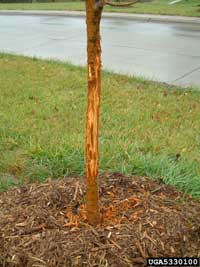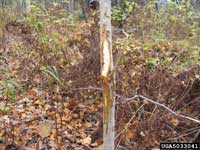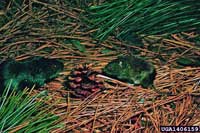Extension > Garden > Diagnose a problem > What's wrong with my plant? > Deciduous > Japanese tree lilac > Bark chewed or removed
Japanese tree lilac > Trunk/branches > Bark chewed or removed
1 of 3
Deer feeding/antler rubbing
- Long lines of shredded or peeled off bark along main trunk up to 3 feet off the ground from antler rubbing; wood may appear shiny or "polished"
- Leaves and small branches
- Feeding occurs from the ground up to 6 feet or slightly higher; ragged edges, same as above; if the bark is removed by a deer there will be no teeth marks
- More information on Problems with deer
2 of 3
Rabbit feeding
- Bark from young trees only is completely removed from the main trunk
- Regular scraping the size of a spoon tip can be seen in the wood
- Damage can occur from ground level to several feet up the trunk depending on the depth of winter snow
- Small twigs are cleanly cut off with a sharp edge, at a 45 degree angle
- Majority of bark feeding occurs in winter and early spring
- Rabbit droppings (small, round pellets) are often found near the damaged shrubs
- More information on protecting trees and shrubs from animals
3 of 3
Vole damage
Microtus spp. and Phenacomys spp.
- On young trees, bark is completely removed from the main trunk in irregular patches
- Scraping the size of fork tines can be seen in exposed wood
- Damage occurs during winter from the ground level up to winter snow depth
- Trees and shrubs appear to "die suddenly" during the growing season, especially if they experience any drought stress












